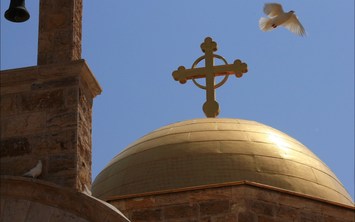
Yesterday we visited Avila, the home of Saint Teresa of Avila, a great saint and mystic and one of only three women recognised as Doctors of the Catholic Church. She's an interesting character. She was born in 1515 and grew up at a time of great turmoil and political unrest. The Protestant Reformation was underway and Spain was enjoying the wealth and prestige which came from the New World discovered by Columbus not too long before. The Inquisition was underway. Jews and Muslims had been expelled unless they converted to Catholicism in an attempt to unify the country under one faith.
Teresa was a child with a romantic, adventurous and perhaps pious imagination as the story of her setting off with her brother to become a martyr under the Moors shows. She entered the convent of the Incarnation in the valley under the walls of the city and lived there for over twenty years. It wasn't a hard or strict life and dissatisfaction with that and growing mystical experiences led her to reform the Carmelite order which she did,founding what are now called Discalced Carmelite monasteries throughout Spain and doing so in spite of great opposition and the threat of the Inquistion. I know Carmelites back home in Scotland and they are the most amazing and joyful women I know but the Carmelite monastery of the Incarnation that Teresa joined and the first one she founded in Avila seemed rather dismal and off-putting though the monastery of the Incarnation does have a waiting list to join - something unlikely to be found elsewhere. It's an enclosed way of life, disciplined with the sisters living a hidden life and praying together seven times a day but in the case of the Spanish convents doing so from behind an iron grille so that you don't see them. It's a hard life, I think, but one that Teresa herself only lived sporadically as she spent much of her time travelling to new foundations. She was accused of being a gadabout and suffered greatly from opposition and bad conditions but perhaps her passionate nature needed this outlet and she certainly felt called by God to do it.
The idea of enclosure and only meeting friends and family from behind a grille is an interesting one. It was set up to protect communities of women and it's been suggested that the grille and enclosure might be influenced by the
seclusion of women in wealthy Muslim homes and palaces. While religions sometimes like to think they are dicrete entitites they have all grown up in contexts where they have influenced one another and are perhaps more eclectic than they think. It could be that the Muslim prayer of five times a day is influenced by the Christian tradition of liturgical prayers said by priests and monastics regularly throughout the day at set hours. And in turn the Christian prayers are likely to be a continuation of the Jewish practice of reciting prayers at certain hours of the day or night. We are a mixture of traditions and this might be the case with our genes as well as our religions. I read recently that our genes can hold traumas that happened to our ancestors. What happens if our ancestors followed another religion. Perhaps we hold those loyalties within us. Teresa of Avila's grandfather was Jewish for example, though today we in the Catholic Church are happy to acknowledge our familial relationship with Judaism..
Medieval Spain was a melting pot of religion. For 300 years, from 8th century until 11th Spain was under Muslim rule and the Arabic influence in architecture and art is clearly seen today. It's sometimes called a Golden Age because Muslims, Jews and Christiand lived together, the arts flourished as did learning and philosophy. There was freedom of religon and
a certain inclusiveness though even in this Golden Age Christians and Jews had what is known as dhimmi status. This meant thay they had to pay higher taxes than their Mulim counterparts and were banned from holding positions of power over Muslims. But there does seem to have been a peaceful co-existence which for Jews was much more positive than it was in Christian Europe. It all came to an end with Isabella and Ferdinand and their desire for a Catholic kingdom which resulted not just in suspicion but in outright hostility to Judaism and Islam. Jews and Muslims were expelled unless they converted and people even became suspicious of these converts' fidelity to their new faith - something which gave rise to the Spanish Inquisition.
Something of this hostility was evident in some of the art work we say this week. In Salamanca cathedral two pictures captured my interest. One was of the Virgin Mary with the Child Jesus between a Jew and a Christian. It was entitled Virgin of Truth and the story goes that in a dispute between a Christian and Jew Mary nodded in the direction of the Christian! Much more sinister was a picture of Jesus being tempted by the devil who looked like a pilgrim apart from the horns and cloven hoofs. What was really disconcerting was the fact that the devil was carrying Islamic prayer beads. Hopefully we have moved on from those days but somehow this energy of conflict, coexistence and suspicion is like a ghost that still lingers. It's up to us which one we develop.


 RSS Feed
RSS Feed
